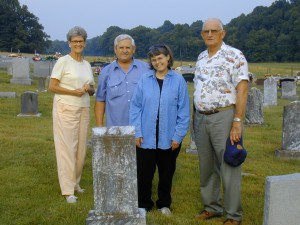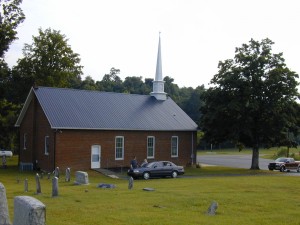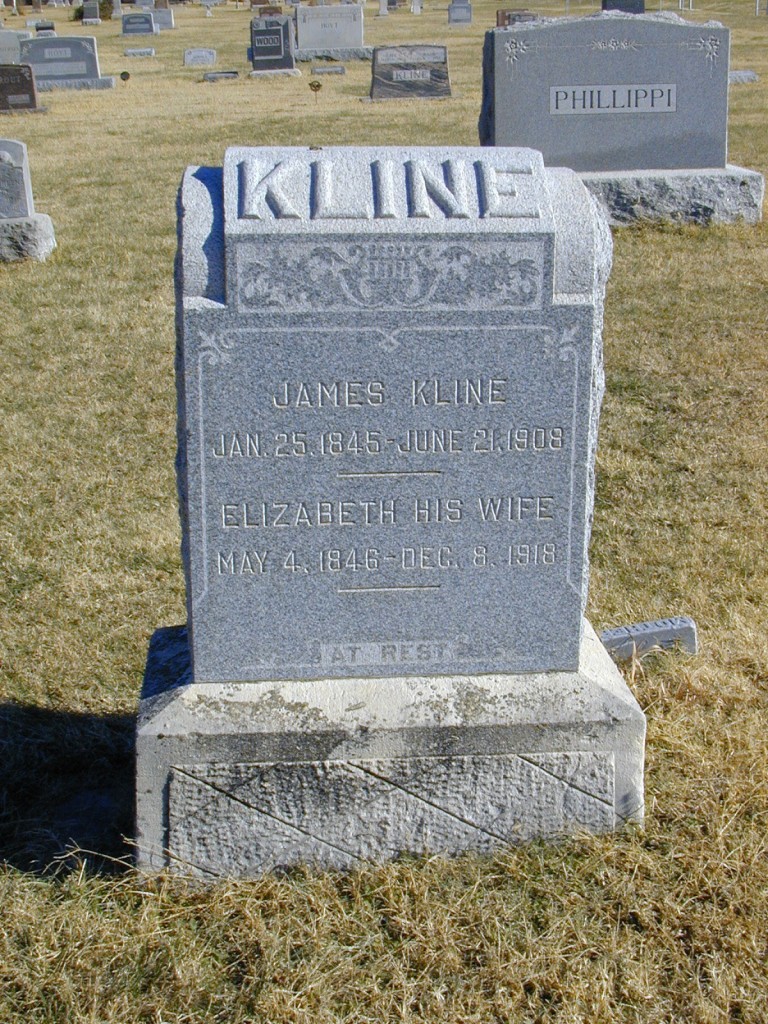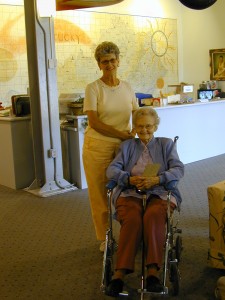Posts Tagged ‘Photographs’
James and Elizabeth (Conver) Kline – Tombstone Tuesday
by Sherry Stocking Kline
November 6th, 2009
On the Stone:
James Kline
Jan. 25, 1945 – June 21, 1908
Elizabeth His Wife
May 4, 1846 – Dec 8, 1918
James and Elizabeth (Conver) Kline are buried in Ryan Township Cemetery, near Milan, Sumner County, Kansas. The cemetery is located one mile west of Milan, Kansas on Highway 160.
James and Elizabeth (Conver) Kline came to Caldwell, Kansas shortly before the 1893 Cherokee Strip Run, where as family story has it, James ran in the Cherokee Strip Run, and when he was not fortunate enough to win free land, he later came to the Milan, Kansas area, where he purchased land along the Chickaskia River south of Milan.
James was born in Clarion County, PA.
Some of the following information includes information that I personally have found, but also includes information that I received from cousin Liz Williams:
Elizabeth Conver was born 4 May 1846 in Richland, Lebanon Co., PA, and was the daughter of of John A. Conver & Marry Huff.
James and Elizabeth were married in Knox, County, Illinois on 31 Oct 1867. They had three sons that died before they came to Kansas, Charles William Kline, born in 1868 but died before 1870, and two more sons, Levi born in 1870 in Illinois and Samuel born in 1872 in Iowa also died young.
After coming to Kansas, they had seven more children. The oldest surviving son, John Conver Kline, was my husband’s grandfather.
James and Elizabeth’s other children were: Newton Oliver Kline, Susan Alica Adilia Kline, James Monroe Kline, Walter Cleveland Kline, Orie Ray Kline, Mae Violet Kline
I would love to connect with other members of my husband’s Kline, Conver, and Huff family to share information, so please leave a comment with your contact info and I will respond asap.
Saturday Night Genealogy Fun – The Day the Genealogy Serendipity Angels Smiled!
The following is from Randy Seaver’s Genea-Musings website! Thank you, Randy!
Yes, it’s Saturday Night, and time for some Genealogy Fun!
My friend, Leland Meitzler, posted his Top Ten list of “Most Satisfying Genealogy Events” yesterday – and it’s a good list – please read it and respond to it if you want to.
For today’s SNGF, if you choose to participate (cue the Mission Impossible music!), please:
1) Tell us about one (or more) “Satisfying Genealogy Moments” from your family history and genealogy research. What was it, and how did it make you feel? You can make a Top Ten list if you want to!
2) Write your own blog post, or make a comment on this post, or make a comment on Facebook, and tell us about your “moment in time.”
The Day the Genealogy Serendipity Angels Smiled!
by Sherry Stocking Kline, October 10, 2009
My Number One favorite all-time Genealogy Experience was one of those “ahhh moments” when Serendipity and the Angels smiled on us.
It was July of 2005, and my husband and I were leaving soon to visit our son in Illinois, and we were taking my mom who was 93 at the time, to Barren County, Kentucky for a day or two and try to locate my Mom’s dad’s childhood home.
I did some research before I left. I re-checked on library hours, wrote down addresses, packed up a notebook (and laptop), and called the South Central Kentucky Cultural Center in Glasgow, Kentucky to talk to the wonderfully helpful woman I had spoken with on a previous occasion.
I nearly hung up the phone…
I nearly hung up the phone when I learned that the woman who had been so warm and friendly before was not working.
That would have been a mistake.
I sighed to myself, decided to take a chance, re-state my facts and share my story with the woman who had answered the phone.
“I’m looking for information,” I said, “about my great-grandfather and great-grandmother, Willis Washington Jones and his wife, Martha Ellen Smith and her parents, Charles and Virginia Hawley Smith.”
There Was Dead Silence…
There was dead silence for at least three heartbeats.
And then she said (and here I still get goosebumps) “Charles and Virginia Hawley Smith are my great-great grandparents, too.”
“Oh. My. Gosh.” I thought.
“Hello, cousin!” was my astonished reply. The genealogical angels had not deserted me; they had given me a wonderful gift!
My brand-new cousin’s name was Nancy Bertram Bush, she was ‘into’ genealogy, and she invited us to give her a call when we got to Glasgow.
A couple of weeks later, we were in Glasgow. I stopped at the courthouse, looked up some land records, and learned more about my great-great grandfather Smith’s land holdings.
When we arrived at the South Central Kentucky Cultural Center, I gave Nancy another call and we were in luck, she was home.
Nancy Had a Gift for Mother…
She hurried over to the Center to meet us, (and a nicer new cousin I can’t imagine meeting). She brought along a treasure, a photograph of my mother’s grandparents (complete with the names) that had been mailed back to the family from Kansas and presented it to my mom.
Mom had never seen photographs of her grandparents and when we brought the photograph home, we were able to identify Willis and his wife Martha in two other photographs that we had.
Nancy offered to take us around Barren County with her husband to try to locate the former home of Willis and Martha Ellen. We went up hill and down dale, we stopped at one family farmstead that had Smith family buried there, and we tramped through tall grass to record names and take photographs, but this was not our destination.
Our next stop proved to be the home of Charles and Virginia Hawley Smith, and we were able to visit with the family and see the land and outbuildings, some of which might have actually been standing during Charles & Virginia’s time.
The Family Cemetery Had Been Returned to Farmland…
Thanks to researching cemetery books we already knew that their family cemetery had been returned to farm land, which was disappointing.

66 - L - R: Nancy Bertram Bush, Norman and Sherry Stocking Kline, Dennis Bush pay respects to family members at the Caney Fork Baptist Church, Temple Hill, Barren County, Kentucky
Next we stopped at the Caney Fork Baptist Church and cemetery and walked through the cemetery and paid our respects to cousins, great-aunts and great-uncles.
When we watched my mother get out of the car and in her words “stand on the land her father had played on as a child” and look around and see “where he came from,” it was a meaningful moment for us all.
We were grateful we were able to help her do this.

Dorothy Barry standing by car next to the Caney Fork Baptist Church & Cemetery - Temple Hill, Barren County, Kentucky
Thank You, Cousin, Nancy…
It was with deep sadness that we received word about two years ago that our new-found cousin, Nancy Bertram Bush, had suffered a heart attack and passed away.
Thank you for a wonderful Genealogical Moment in Time, cousin Nancy.
Journal Your Summer Photos Now!
by Sherry Stocking Kline
first published in Wichita Eagle’s Active Life Magazine – September 2000
Now that summer’s over, and you’ve got a shoebox full of vacation, grandchildren, wedding, and graduation photographs, it’s time for you to preserve those memories between the pages of a book, like a pressed flower, to be enjoyed again and again.
So where do you start first?
“Get some history attached to those photos,” said Bob McCreary, “that’s the first and probably the most important step.”
McCreary and his wife Kathy co-own Scrapbook Garden, Wichita, Kansas. McCreary said that Kathy carries photographs with her in her purse and whenever she has a few minutes while watching television, waiting for the doctor, or waiting to get a driver’s license she sorts photos and makes quick notes on the back with a photo safe pencil.
Once you have them sorted, McCreary said it’s really a quick step after that to put the photos in an acid-free, lignin-free photo album, and then “journal” or tell about the photos.
Each year, Gerry Reimer does a summer vacation album, and adds more pages to her all-Christmas album.
Journals Don’t Have to Be Elaborate…
Reimer said not to let your friends’ elaborate journals scare you off. “Streamline,” Reimer said, “get the photos on the page, and get the people identified.”
“First of all,” Reimer said, “Tell yourself it’s o.k. not to use all the photos you have.” Reimer said to choose pictures that tell who you are and where you were at that time, and be sure and include names and dates in your albums.
“I don’t keep a travel diary,” Reimer said, but Reimer said she jots down a few notes, picks up ticket stubs, colored brochures, saves travel itineraries and whatever else they might want to use in their vacation albums.
Reimer said you’ll know what you want to do, and what you don’t, after you finish your first book. Reimer’s first photo album was her wedding album.
“We’d been married 49 years,” Reimer said, and I didn’t like our wedding photos, so I had a wonderful time cropping off what I didn’t like and journaling about the pictures.” Reimer said she does “bullet journaling”, or writes short statements under most photos, saving long stories for special photographs or events.
Start With Recent Photo’s…
Bonnie Loewen, Creative Memories consultant, said the easiest way to get started is with your last roll of film while your memory of the event is fresh, and work your way backwards.
Tell A Story…
Loewen said to tell a story with words as well as with pictures. How were you feeling? What was going on in the family, and the world? Loewen said even the current price of bread and gasoline will be interesting to future generations.
Loewen said to write as you would talk, don’t worry about punctuation, and write a sloppy first draft. You can re-write it later, Loewen said.
Answer the Five W’s – Engage the Five Senses…
Think about the five senses and the five W’s, advised both McCreary and Loewen, adding that it will make ideas for captioning your photos come easier. Just remember to answer the questions who, what, when, where, and why questions, and engage the emotions by writing about how something looked, sounded, tasted, felt, and smelled.
Preserve Your Handwriting, too…
McCreary said and its faster to use a computer to journal, but it’s not as personal, so he said not to be afraid to write in pencil and go over it later with a permanent marker, or even cover up mistakes with cardstock.
“Some people don’t like their handwriting,” McCreary said, “but people years from now will cherish seeing the handwriting of the person who made the journal.”
Scrapbooks can help bridge the generation gap, so along with vacation, wedding and family photos, include stories and pictures of military service and other events to help future generations understand the times you lived through, and what makes your family special.
Ordinary Days are Important…
Loewen said it’s also good to make pages of what an ordinary day was like in your family, too, not just the special events. “And make a signature page,” Loewen said, with your name, date, who the album is for, and why you did it, “it’s kind of like signing a quilt.”
If you have a lifetime of photographs ask for help from your family. Reimer said that kids and grandchildren are great to help photo captions.
McCreary agreed, “it’s good to get family members involved.”
“Make it a fun activity,” McCreary said, “have everyone sit down and talk about the photos, and try to communicate some of the emotion.” You get different perspectives of an event by talking to different people.
“It’s really exciting that people are making a legacy and trying to pass on their roots and their values,” Loewen said, “values can be lost in one generation if they are not preserved.”
“People will forget you in one generation if you don’t tell your story,” Loewen said, “you can make such a difference in people’s lives with a scrapbook.”
“In a sense,” Reimer said, “your whole book is the story of your family.”
Keep Your Family History From Ending up in the Dumpster
By – Sherry Stocking Kline
Printed in Wichita Eagle’s Active Life Magazine – Aug 04
The nightmare of many genealogists is that the minute they die their kids will haul years of family history research, one-of-a-kind documents, and priceless photographs out to the curb for the first trash truck that comes along.
What can you do to keep countless hours of research and family history from becoming part of tomorrow’s landfill?
First, make sure you have something someone will want to keep. If you leave behind a jumbled up pile of unidentified photographs, mixed-up documents, and notes with no organization, your genealogical heir may throw up his (or her) hands and throw in the towel.
Your research “has a much better chance to be saved if it’s organized,” said Donna Woods, former librarian for Midwest Historical and Genealogical Society.
“My granddaughter’s husband sat me down one day,” and told me that I needed to get it (my genealogy materials) in some kind of order because if something happened to me they wouldn’t know what to do with it.”
Woods said that she doesn’t believe it makes any difference what system you use, just that you use one, and don’t use the ‘pile-it’ method, though she added that she still does “have a few piles” even after organizing with file folders and notebooks.
“Mark in your books which ones are keepers and should not leave the family,” Woods said, adding she wrote a note inside the cover of each book that pertain to the family.
Nancy Sherbert, curator of Photographs, Kansas State Historical Societysuggested that you label documents, write on photographs, and organize materials into family groups alphabetically. Sherbert said photographs without identification or dates have very little meaning to family members or as historic documents.
“We don’t think about that when we take our photographs,” Sherbert said, “we know who they are. But when we’re gone, others can’t appreciate the historical value of those photographs because they don’t know who the people are, what they are celebrating, and why they are all together.”
Woods said you should have a really serious discussion with your family, and see if someone is interested in your genealogy work.
“It may not be your child,” Woods said, “it may be a grandchild or a niece or nephew.” Woods’ daughter was not interested in furthering her genealogy research, but a discussion with a granddaughter in her mid-twenties rewarded Woods with a possible new home for her research.
“I’m so glad that you are doing this, Grandma,” said Wood’s mid-twenties granddaughter, “I want to do it someday, but I can’t do it right now.”
Preserving your family’s history doesn’t necessarily mean keeping all the information in your immediate family. Woods said she made the decision to place some of her research where it would do the most good, in the two counties in Illinois where her ancestors originally resided.
“It makes a lot more sense to place my research there in those counties,” Woods said, “for other researchers to find.”
Once you’ve made sure that no one in your family wants your collection, the safest way to keep your materials out of the dumpster, according to Sherbert, is to add to your will “I’d like for my photographs, letters, and diaries to be donated to…….
“Go ahead and establish some kind of collection with an institution,” Sherbert said, “and make it clear to your executor and family that remaining materials are to go to the institution.”
“Just make some sort of arrangements,” Sherbert said, adding that materials donated to a historical society, library, or museum should be preserved and available for research for decades “unless there is some kind of preservation problem.”






